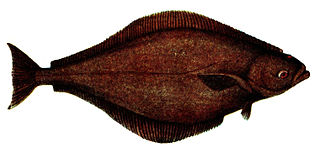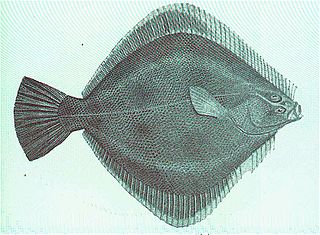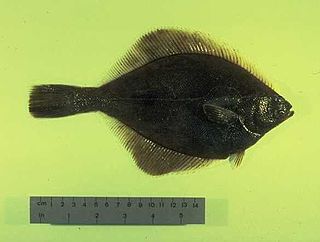
Flounders are a group of flatfish species. They are demersal fish, found at the bottom of oceans around the world; some species will also enter estuaries.

A flatfish is a member of the ray-finned demersal fish order Pleuronectiformes, also called the Heterosomata, sometimes classified as a suborder of Perciformes. In many species, both eyes lie on one side of the head, one or the other migrating through or around the head during development. Some species face their left sides upward, some face their right sides upward, and others face either side upward.

Halibut is the common name for three flatfish in the genera Hippoglossus and Reinhardtius from the family of right-eye flounders and, in some regions, and less commonly, other species of large flatfish.

The European plaice, commonly referred to as simply plaice, is a species of marine flatfish in the genus Pleuronectes of the family Pleuronectidae.

Demersal fish, also known as groundfish, live and feed on or near the bottom of seas or lakes. They occupy the sea floors and lake beds, which usually consist of mud, sand, gravel or rocks. In coastal waters they are found on or near the continental shelf, and in deep waters they are found on or near the continental slope or along the continental rise. They are not generally found in the deepest waters, such as abyssal depths or on the abyssal plain, but they can be found around seamounts and islands. The word demersal comes from the Latin demergere, which means to sink.

The common dab is an edible flatfish of the family Pleuronectidae. It is a demersal fish native to shallow seas around Northern Europe, in particular the North Sea, where it lives on sandy bottoms down to depths of about 100 metres (330 ft). It can reach 40 centimetres (16 in) in length and can weigh up to 1 kilogram (2.2 lb), though most specimens grow no longer than 20 centimetres (7.9 in).

Bothidae or lefteye flounders are a family of flounders. They are called "lefteye flounders" because most species lie on the sea bottom on their right sides, with both eyes on their left sides. The family is also distinguished by the presence of spines on the snout and near the eyes.

Sole is a fish belonging to several families. Generally speaking, they are members of the family Soleidae, but, outside Europe, the name sole is also applied to various other similar flatfish, especially other members of the sole suborder Soleoidei as well as members of the flounder family. In European cookery, there are several species which may be considered true soles, but the common or Dover sole Solea solea, often simply called the sole, is the most esteemed and most widely available.

The Atlantic halibut is a flatfish of the family Pleuronectidae. They are demersal fish living on or near sand, gravel or clay bottoms at depths of between 50 and 2,000 m. The halibut is among the largest teleost (bony) fish in the world, and is a threatened species owing to a slow rate of growth and overfishing. Halibut are strong swimmers and are able to migrate long distances. Halibut size is not age-specific, but rather tends to follow a cycle related to halibut abundance.

The yellowtail flounder, also known as the rusty dab, is a species of flatfish in the family Pleuronectidae. Reaching 56 cm (22 in) in length, it has reddish brown upperparts, pale underparts and yellow fins. Both its eyes are on the right (upper) side of its body. Found in the western North Atlantic, it has been fished commercially by North American fisheries for food. A victim of overfishing, the yellowtail flounder is categorized as "Vulnerable" by the International Union for Conservation of Nature.

Limanda is a genus of righteye flounders native to the northern Atlantic and Pacific oceans.

Hippoglossus is a genus of very large righteye flounders with one species native to the north Atlantic Ocean and one to the north Pacific Ocean.

Platichthys is a genus of flatfish native to the North Pacific and North Atlantic oceans. Despite being in the family Pleuronectidae, all three species in the genus Platichthys are often "lefteyed", i.e. they lie on the sea bottom on their right side, with both eyes on the left side.

The Pacific sand sole, also known as simply sand sole, is a flatfish species inhabiting the northeastern Pacific waters where it lives on sandy bottoms. The only species in the genus, Psettichthys, it ranges from the Bering Sea to Northern California.

Pleuronectinae is a subfamily of fish in the family Pleuronectidae, comprising 27 genera and 62 extant species. Members of the subfamily are demersal carnivores that live in arctic and northern seas.

The Poecilopsettidae are a family of flatfish in the order Pleuronectiformes, comprising three genera and 21 species. Species are typically demersal, living on marine bottoms at depths between 60 and 500 m in the Indo-Pacific and northwestern Atlantic; the deepest recorded occurrence is 1,636 m (5,367 ft) in the deepwater dab, Poecilopsetta beanii. Sizes range from 9 to 19 cm in length, though most species are usually under 15 cm (5.9 in) long. Diets consist of zoobenthos.

Rhombosoleidae is a family of flatfish in the order Pleuronectiformes, comprising nine genera and 19 species; all members of this family are right eye flounders with asymmetrical pelvic fins. Species are typically demersal, living on bottoms in temperate marine waters on the continental shelf, although some species of Rhombosolea enter fresh water in New Zealand. Most are restricted to waters around Australia and New Zealand, though the Remo flounder, Oncopterus darwinii, occurs in the southwestern Atlantic and the Indonesian ocellated flounder, Psammodiscus ocellatus, occurs in Indonesia.

Plaice is a common name for a group of flatfish that comprises four species: the European, American, Alaskan and scale-eye plaice.

The yellowfin sole is a flatfish of the family Pleuronectidae. It is a demersal fish that lives on soft, sandy bottoms at depths of up to 700 metres (2,300 ft), though it is most commonly found at depths of around 91 metres (299 ft). Its native habitat is the temperate waters of the northern Pacific, from Korea and the Sea of Japan to the Sea of Okhotsk, the Bering Sea and Barkley Sound on the west coast of Canada. Males grow up to 49 cm (19 in) in length, though the common length is around 33.5 cm (13.2 in). The maximum recorded weight is 1.7 kg (3.7 lb), and the maximum recorded lifespan is 26 years.
The narrow-body righteye flounder is a flatfish of the family Pleuronectidae. It is a demersal fish that lives on saltwater bottoms at depths of between 218 and 438 metres. Its natural habitat is the waters of the Indo-West Pacific, from the Bali Strait to Northern Territory, Queensland and New South Wales in Australia. It can grow up to 15 centimetres (5.9 in) in length.






























